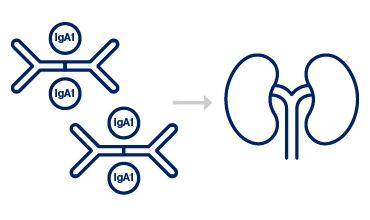What is IgA nephropathy?
IgA nephropathy (IgAN) is a progressive, rare kidney disease and is a major cause of chronic kidney disease and kidney failure.1 Annually, around 25 people per million worldwide are newly diagnosed with IgAN.2
What causes IgAN?
IgAN disease is driven by four steps:3,4
- An abnormal form of immunoglobulin A (IgA) is produced.
- Autoantibodies are made against this abnormal form of IgA.
- Immune complexes containing IgA are formed.
- These immune complexes deposit in the kidneys, triggering a series of downstream pathways, including an inflammatory response, leading to progressive kidney damage and loss of kidney function.
What are the symptoms of IgAN?
IgAN is particularly hard to diagnose. Individuals in the early stages of the disease often don’t show symptoms, resulting in many patients receiving a diagnosis after they have already experienced significant kidney damage.5,6
IgAN can only be correctly diagnosed through a medical procedure called a kidney biopsy.7
Common signs and symptoms include:5,7
